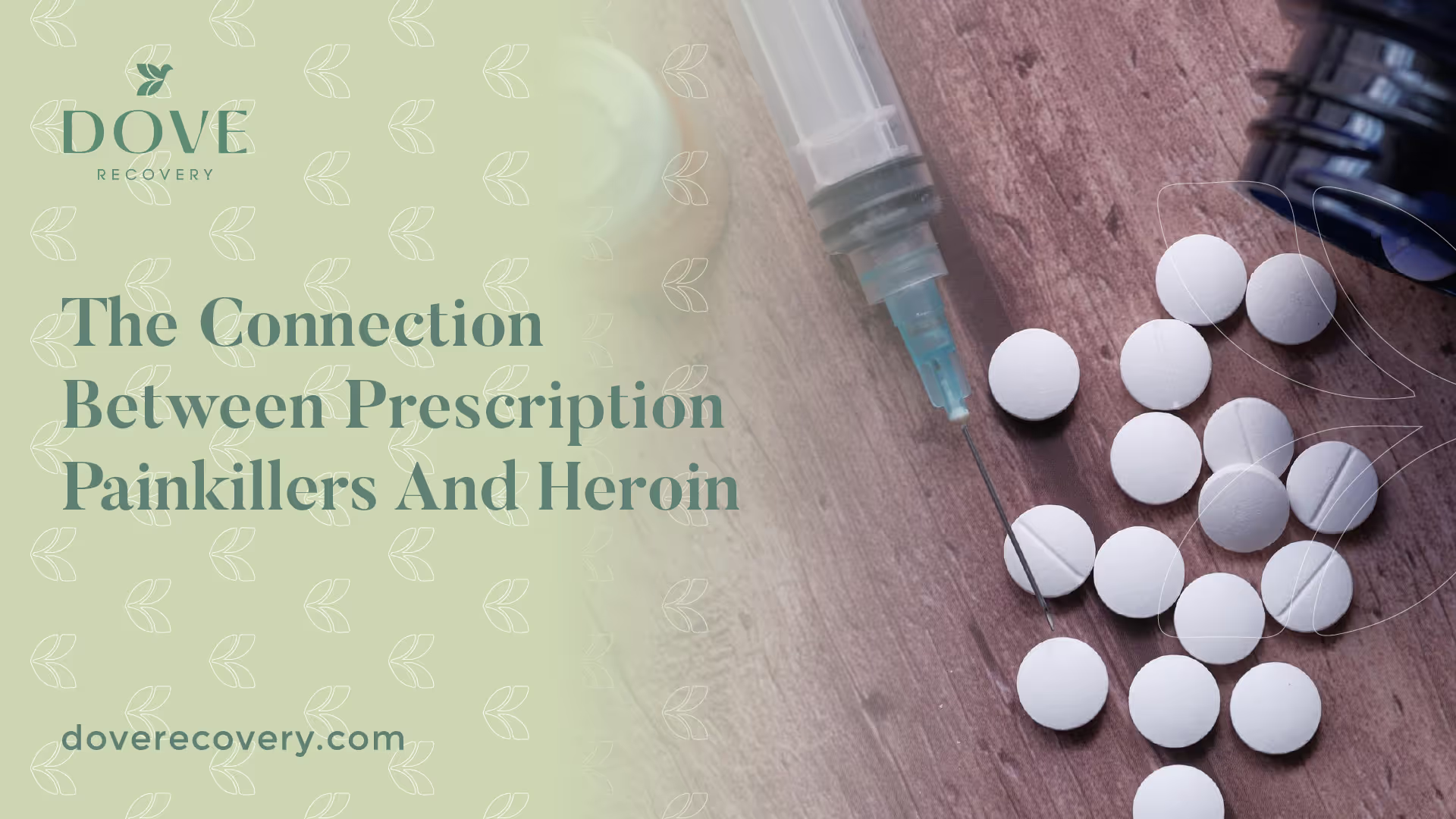The Connection Between Prescription Painkillers And Heroin

Prescription Painkillers and Heroin
Unraveling the intricacies of drug abuse and addiction, it's crucial to understand the underlying connections between different substances. One such link exists between prescription painkillers and heroin.
Risk Factors for Heroin Use
The path leading to heroin use can be paved with prescription painkillers. One of the major risk factors for heroin use is the misuse of prescription opioid pain relievers, as stated by Health Canada. The misuse of these drugs sets a dangerous precedent, increasing the likelihood of users transitioning to heroin.

Within five years of initial misuse of prescription opioids, it's reported that 3.6% of users initiate heroin use [1]. This statistic underlines the urgency of addressing prescription opioid misuse. However, it's worth noting that the current opioid overdose epidemic is fueled more by illicit substances like fentanyl and heroin than by prescribed opioids.
Prescription Opioid Misuse Patterns
Prescription opioid misuse is a significant concern in the United States. According to the NCBI, the incidence of prescription opioid abuse or dependence increased from 1.5 million in 2002 to 1.8 million in 2011. As a result, opioid analgesics became the most commonly abused illicit drugs after marijuana in 2011.
This misuse has dire consequences. The number of deaths due to opioid analgesic overdose escalated from 4,000 in 1999 to 16,651 in 2010. This disturbing trend emphasizes the need to better understand and address the problem of prescription opioid misuse.
Understanding the connection between prescription painkillers and heroin is a key step in curbing the opioid epidemic. It's important to recognize the risk factors and patterns of misuse to develop effective prevention and treatment strategies.
Impact of Prescription Opioids
Prescription opioids have a significant impact on individuals and society, particularly when misused. This section will delve into the disturbing statistics related to opioid overdose and the predictions for opioid-related deaths.
Overdose Statistics
The misuse of prescription opioids has led to a considerable increase in the number of overdose deaths. According to the NCBI, the number of deaths due to opioid analgesic overdose jumped from 4,000 in 1999 to 16,651 in 2010. However, it's important to note that the sharp increase in overdose cases recorded in 2014 was driven by illicit fentanyl and heroin, not opioid prescribing [1]. This indicates a shift from prescription opioids to illicit substances, underscoring the complex nature of the opioid crisis.
Opioid-Related Deaths Prediction
Looking ahead, the outlook remains bleak with regard to opioid-related deaths. Under the status quo, the model predicts approximately 547,000 opioid-related deaths from 2020 to 2024, rising to 1,220,000 by 2029 [2]. These figures are shocking and underscore the urgent need for comprehensive strategies to combat the opioid crisis.
However, there are measures that can significantly reduce these figures. For instance, expanding naloxone availability by 30% could avert 25% of opioid deaths. Other measures, such as pharmacotherapy, syringe exchange, psychosocial treatment, and prescription monitoring programs (PMPs), can also lead to reductions in opioid-related deaths while improving life years and quality-adjusted life years (QALYs) [2].
These figures highlight the pressing need to address the connection between prescription painkillers and heroin, and to implement effective measures to prevent and treat opioid misuse.
Transition to Heroin Use
Understanding the transition from prescription painkillers to illicit drugs like heroin is crucial in tackling the opioid epidemic. This section explores the direct link between prescription opioids and heroin, along with the multiple factors that contribute to this transition.
Link Between Prescription Opioids and Heroin
There is a significant connection between the misuse of prescription opioid pain relievers and heroin use. According to Health Canada, one of the major risk factors for heroin use is the misuse of prescription opioid pain relievers. As stated by PubMed, within five years of initial misuse of prescription opioids, 3.6% of individuals initiate heroin use.
It's important to note that the current opioid overdose epidemic is primarily fueled by illicit substances such as fentanyl and heroin, not by prescribed opioids. This signifies a shift in the nature of the opioid crisis, with illicit substances posing a growing threat to public health.
Factors Contributing to Transition
There are various factors that contribute to the transition from prescription opioids to heroin. One of the most significant risk factors for problematic opioid use behaviors among people with chronic non-cancer pain include younger age, substance dependence, mental health histories, and higher opioid doses.
Moreover, co-occurring lifetime and current diagnoses of psychiatric disorders, primarily mood disorders, and other substance use disorders are also significant risk factors for the development of opioid use disorder (OUD). Shared genetic factors contribute to the pleiotropy between OUD and both mood and substance use disorders [4].
Understanding these risk factors is crucial in developing effective prevention and intervention strategies. By identifying individuals at risk of transitioning from prescription opioids to heroin, it is possible to provide timely and appropriate support to prevent the escalation of substance misuse.
Mental Health and Opioid Use
In the context of the connection between prescription painkillers and heroin, it's crucial to understand the role of mental health. There's a significant link between co-occurring psychiatric disorders and opioid use, which can impact treatment outcomes.
Co-Occurring Psychiatric Disorders
Psychiatric disorders in drug-dependent populations are common, with a prevalence rate of 45.1% for co-occurring mental illness in patients with past-year substance use disorder. In particular, the prevalence of current and lifetime depression among individuals with opioid use disorder (OUD) is estimated to be 19% and 24%, respectively.
Co-occurring lifetime and current diagnoses of psychiatric disorders, primarily mood disorders, and other substance use disorders are significant risk factors for the development of opioid use disorder (OUD). Shared genetic factors contribute to the pleiotropy between OUD and both mood and substance use disorders.
Impact on Treatment Outcomes
The presence of co-occurring psychiatric disorders can also impact the outcomes of treatment for opioid use. According to a study, participants with a co-occurring psychiatric disorder had greater impairment on several clinical indicators at baseline, but had better opioid use outcomes at the conclusion of 12 weeks of buprenorphine-naloxone stabilization than participants without a co-occurring disorder.
However, additional research is needed to determine the causal mechanisms that account for differences between prescription opioid users with and without co-occurring psychiatric disorders, and to determine how best to adapt treatments for this specific population [5].
In conclusion, addressing mental health issues is an integral part of understanding and treating opioid use. With further research and individualized treatment plans, it's possible to improve outcomes for individuals struggling with opioid use and co-occurring psychiatric disorders.
Long-Term Effects of Opioid Use
Understanding the long-term effects of opioid use necessitates a closer look at problematic opioid use behaviors and the indicators of extra-medical opioid use. These factors illuminate the connection between prescription painkillers and heroin, which is crucial for prevention efforts.
Problematic Opioid Use Behaviors
Problematic opioid use behaviors develop over time and are influenced by a multitude of factors. According to a study on people with chronic non-cancer pain, the most important risk factors for problematic opioid use behaviors include younger age, substance dependence, mental health histories, and higher opioid doses [3].
This study also revealed that a significant 85% of participants were still taking strong opioids after 5 years, illuminating the chronic nature of opioid dependence [3].
These findings underscore the need for comprehensive and ongoing assessments for individuals prescribed long-term opioids.
Indicators of Extra-Medical Opioid Use
Extra-medical opioid use refers to the use of prescription opioids in ways or amounts not intended by the prescribing doctor, or for reasons other than those for which the medication was prescribed. Indicators of potential extra-medical opioid use decreased from 38% at baseline to 25.4% at the 5-year follow-up among those taking opioids for chronic non-cancer pain [3].
Higher opioid doses were associated with greater prevalence of potential indicators of extra-medical opioid use, patient concerns about opioid use, and opioid dependence. However, the strength of the associations between opioid dose and these outcomes diminished after controlling for other factors [3].
These research findings shed light on the potential dangers of long-term opioid use and the need for continuous monitoring and reevaluation of patients' opioid use behaviors. They also underline the importance of patient education and the use of multimodal pain management strategies to minimize the risks associated with prolonged opioid use.
Substance Use and Opioid Misuse
Delving deeper into the connection between prescription painkillers and heroin, it's important to explore the role of polysubstance use and comorbid substance disorders in exacerbating opioid misuse.
Polysubstance Use Patterns
Polysubstance use, which refers to the consumption of multiple substances concurrently, is highly prevalent among individuals with Opioid Use Disorder (OUD). Rates of polysubstance use can range from 45.5% to 92.9% depending on the severity of opioid exposure. Notably, polysubstance use significantly increases the risk of opioid misuse, withdrawal symptoms, and overdose incidents.
These figures underscore the importance of comprehensive substance use assessments in individuals with OUD in order to effectively manage polysubstance use and mitigate the potential risks.
Comorbid Substance Disorders
Comorbid substance disorders, or the simultaneous presence of two or more substance use disorders, further complicate the landscape of opioid misuse. Among individuals with OUD, nicotine and alcohol use disorders are the most common comorbid conditions. Prevalence rates are as high as 98% for nicotine and 46% for alcohol.
Nicotine dependence is particularly concerning as it is associated with higher rates of smoking-related morbidity and mortality. Moreover, nicotine dependence can lead to poorer treatment outcomes for OUD. The high prevalence of these comorbidities highlights the need for integrated treatment approaches that simultaneously address opioid misuse and comorbid substance use disorders.
In conclusion, polysubstance use and comorbid substance disorders play a significant role in the misuse of opioids. Understanding these patterns can help in the development of more effective prevention and intervention strategies, ultimately aiding in the fight against the opioid epidemic.
References
[1]: https://pubmed.ncbi.nlm.nih.gov/28402482/
[2]: https://www.ncbi.nlm.nih.gov/pmc/articles/PMC8592267/
[3]: https://www.ncbi.nlm.nih.gov/pmc/articles/PMC7700907/
